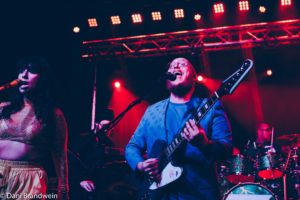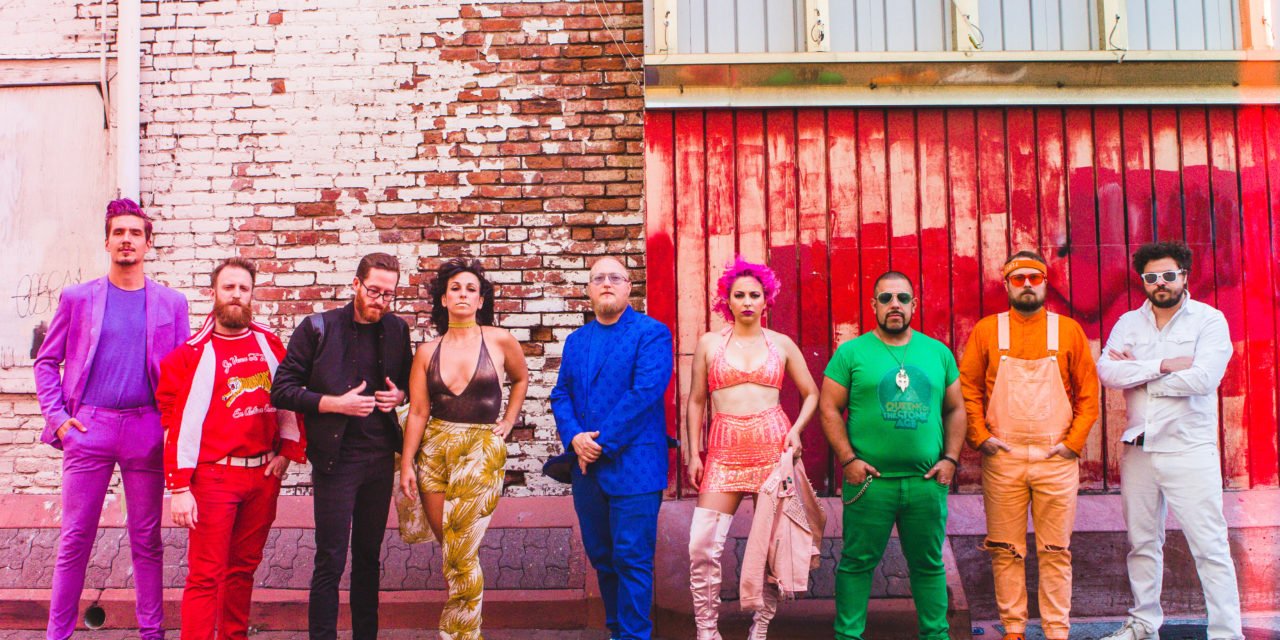
Photo by: Dani Brandwein
Dave Brandwein: inside the band’s vibrant new record, Life in the City
Drip painting entails actively splashing a myriad colors on a canvas.
Popularized by Jackson Pollock, Janet Sobel, Max Ernst, and other 20th century luminaries, the artform itself relies on action and motion. In similar fashion, energetic splashes of funk, alternative, rock, R&B, and psychedelia color the music of Turkuaz. Balancing male-female harmonies, strutting guitars, wild horn arrangements, and interminable grooves, this spirit takes shape in the color donned by each respective member on stage nightly via larger-than-life performances.
The Brooklyn-based nonet—Dave Brandwein [guitar, vocals], Taylor Shell [bass], Craig Brodhead [guitar, keys], Michelangelo Carubba [drums], Chris Brouwers [trumpet, keys], Greg Sanderson [tenor sax], Josh Schwartz [baritone sax, vocals], Sammi Garett [vocals], and Shira Elias [vocals]—ignite an explosion of energy punctuated by neon hues, deft musicality, and show-stopping singalongs on their fifth full-length album, Life In The City.
Prior to embarking on a 24-date tour run, I had the chance to catch up with Brandwein, who shares the band’s artistic vision – inside and outside of the city.

Photo by: Dani Brandwein
Life in the City is now out and you are about halfway through the first tour run, how are you feeling and how has the new record experience been so far?
I’m feeling very good about it. Most fans I’ve had the pleasure of interacting with have firmly said this is their favorite album of ours to date. That’s a really good feeling. We’ve played the entire record live, and as usual, we’re having fun with the arrangements of the songs, bringing them to life in a different way on stage. We always strive to keep the essentials intact, while expanding and stretching out in certain places to give the live versions of songs a unique energy. That’s always been a big part of our live show and the material on the new album is no exception. Seeing a positive reaction to both the album and the shows is really gratifying after spending lots of time prepping this release.
When you think about the spectrum that is Turkuaz and the “gray” that can be the concept of distractions in a city, there seems to be a very complimentary balance between the two. Do you feel the new music represents a unique (and colorful) perspective on modern city life?
It represents both sides of the coin. I think the most striking thing about this album is that at times it can be lyrically very dark, but the music underneath is still upbeat and energetic. This speaks strongly to how I see life. No matter how dark things get on the surface, an underlying positivity and optimism is ultimately necessary in moving forward.
And yes — Life in the “City” refers to the hustle and bustle of modern life, constant stimulation and distraction, and feelings of isolation despite being constantly “plugged in” and connected with everyone and every-thing.Some songs go further into how this all takes place in the mind, which can become its own eco-system or “city” that we live inside of, no matter where we are in the physical world. Maybe that’s a little too heady, but really it’s just meant to show that some of these issues really exist within ourselves. The perspective we take on it really determines what the outcome will be. The album doesn’t claim to have any answer, it’s just sorting through the madness!
It’s fascinating that for the first session you had to get far away from city life physically. Was that necessary in order to properly capture the feeling of the songs?
Well, it wasn’t quite that intentional, but it did help to get a little distance from it all!
On our last album, Digitonium, we went upstate to More Sound Recording Studio in Syracuse, NY. It was a place we could all stay and live for a little while during the process, and it made for a really collaborative and exciting feeling. Not to mention that our good friend who owns and runs the studio Jason “Jocko” Randall is incredible to work with and forever changed my view on recording and production.
When starting this record, we didn’t want to mess with a good thing. So we started out with the same process, and went up there to stay and record at the studio. As it turned out, this album just took so many rounds of writing and recording to get it where we wanted it, that we ended up doing all the rest of it at my studio in Brooklyn over the course of another year or two.
Given all the harmonic layers, how does a Turkuaz song start? Is it as simple as a guitar or piano melody to build off of?
It very rarely starts by sitting with a guitar or piano, though I think that simpler approach is something I’d be interested moving to on the next album. But thus far, it’s almost always started with a demo that either myself, Taylor or Craig will create. Then, typically, I’ll write over the demo, but more and more other members are collaborating in some of that process. From there, we bring it into a rehearsal or a soundcheck and people start having fun with the arrangements and we bring it to life.
On the last two records, we often will use pieces of the demo in constructing the song in the studio, which can make for some really interesting results. It’s been a lot of fun doing it that way, but now that we’re about to get started on writing the next album, we’re gonna bring the emphasis back on starting with our instruments in hand and taking it from there.
You open the record saying, “Living day-to-day people find a way to smile and look to the future.” And then the last thing you hear is “Can you fight the fire?” followed by a two-minute instrumental outro. There’s quite a journey within there. Was that your intention – to have this exploratory approach?
Absolutely. In that first line you mentioned, there is both positive and negative. “Living day to day, people find a way to smile and look to the future.” This partially refers to the ability for us to get immersed in distraction and ignore the problems we face in the world and within ourselves. Instead of dealing with them, we numb ourselves with substances, entertainment, and the general hedonistic lifestyle we’re currently wired for and encouraged to partake in. However, it also refers to the flipside. You can’t only focus on the negative. The key to a productive and positive life that brings joy to you and those around you is the ability to keep a positive prospective, and look forward instead of backward. So within the first line alone there is a lot of exploring that could be done.
“Can you fight the fire?” refers to the inevitability of struggle and conflict. It will always be there. In closing the album it seemed like an appropriate question. Can you handle what life has in store? Are you ready for it? The answer reveals itself every day, but sometimes it’s important to stop and prepare yourself.

Photo by: Dani Brandwein
Is there reasoning behind the colors each person in the band gravitates towards? You seem to always sport blue?
We’ve all been in our colors for a long time now. The only time we ever switched was for this last Halloween. Otherwise, we keep it consistent. Years ago, Dani (my wife and Creative Director for the band) found everyone a jumpsuit in a different color to wear on stage. At the time it was one of many different sets of wardrobe we had. But after a while we decided to take the “colors” idea and run with it. So now each member has an extensive variety of wardrobe in their designated color. I think each person has really grown into their color, rather than the other way around.
It’s a big part of our show. We’re unsure if it’s something that will remain forever, but it’s served us well. With so many of us up there, it helps to represent the individuality of each person, while also displaying how we add up to a whole greater than the sum of its parts. When you look across the stage, it represents the sonic spectrum you hear in a very visual way and we like that.
Given the real-life experiences you focus on in this record, it must be quite an expressive feeling to perform the record live so “colorfully”. Can you explain what that has been like knowing where the songs came from?
Definitely. Going back to the difference between the live show and the recorded material — you probably will find more darkness or the “gray”-ness you referred to on the albums. The recorded versions are meant to be a place where we can really dig deep into a different side of what we do musically, especially on the last two albums. Each recording is its own piece of art, like a painting that can stand on its own. Some are colorful and bright, and others are meant to set a darker tone, for a more introspective listen.
When we bring it to the stage the intention changes a little bit. I sometimes think of Turkuaz shows as a cross between art and sports. I know that sounds funny — but we bring an athletic element to it. We play as a team and we push ourselves to the limits of our abilities. It’s an energetic performance and we like it when the crowd goes wild. This inherently changes how we perform the material. The composition is still there, but we’re squeezing out every last drop of energy. It’s what we’re known for, and though we keep expanding the depth of our show, that part will never really go away.
What are you most looking forward to with this record and tour?
The biggest thing is just knowing that our music is reaching new people every single day. That’s still very exciting to us. We’re having a blast playing the shows and getting to expand on the material live. Of course we always have high hopes for the album and we hope that the recordings reach new heights in popularity as time goes on. But we have a loyal fan-base of amazing people – and just knowing that we bring them joy in what we create is really what counts at the end of the day. If we were just serving ourselves by doing this, I think any success would ultimately feel hollow. The joy we bring others makes it worthwhile.
Coming full circle, what does Life in the City mean to you?
It’s the good and the bad. It represents the whole spectrum. What is exciting can also be nerve-wracking. What is calm can be boring. You have to give something to get something. The city around us and the city in our minds can be made into the same reality, and we are the ones who select our own fate. Of course things do happen outside of our control, but how we react is everything, and it determines what the future holds. Can you handle the noise? Can you fight the fire? Can you keep your head together?
I’m still figuring out what a lot of it means to me, and the takeaways really didn’t start to solidify until the process was complete and the album was released. And even still, I’m learning every day. There is a surprise and an opportunity around every corner. That’s the idea behind Life in the City.
*Life in the City is out everywhere now.
Catch Turkuaz on tour starting December 28th at the House of Blues Cleveland and don’t miss their special New Year’s Eve show ~ The Ball Drop at the Palladium in Worceseter, MA.


